By David Higginbotham
The .308 battle rifle is making a comeback. Ruger released their SR762 to high praise. Colt’s modular 901 can accept uppers in .308 and .223. The AR10 is still alive and kicking, and rocking throwbacks, like Springfield Armory’s MiA line, manage to be both nostalgic and innovative. What is it about the hard-hitting 7.62 x 51 that makes it so appealing? Wasn’t the high-pitched crack of the AR-15 sound the death knell of oversized, overweight, overkill? Apparently not. There’s more staying power in the old-school battle rifle than the slew of 5.56 rifles would have us believe. None of this is news to the fans of the H&K G3. Yet import restrictions make the G3, and the H&K 91 (the civilian version of the G3) hard to come by stateside. Don’t give up hope. At the upcoming SHOT show in January 2014, PTR will launch a new version of the Classic Wood 91, the KR. The K is for Kurz, which refers to the 16-inch barrel. The R denotes a welded rail. With a shorter barrel and a rail, the new iteration will appeal to those who respect the classic look of an old G3. It will also speak to those who want a hard-hitting CQB rifle with manageable length and the option to more easily add optics. If you are looking for heavyweight precision, with just a hint of German engineering, take a good long look at the PTR 91. These American-made 91s are taking the iconic H&K design to new levels of precision and reliability.
PTR
PTR isn’t jumping on the .308 bandwagon. The company was founded to make solid reproductions of the H&K 91 for the American market. While PTR is hardly a household name, the company’s reputation is growing. It has recently begun a phased move to South Carolina, which should be complete in early 2014. The relocation will add to the growing list of arms manufacturers vacating Connecticut for warmer, friendlier climes. The South Carolina move will include an expansion of PTR’s production capabilities, as the company will take over all aspects of barrel manufacturing. The current barrels are top notch, yet the early production coming out of the South Carolina plant is turning out even better accuracy.
The H&K 91 is a modified version of the H&K 41, which is the civilian version of the H&K G3, a rifle that’s still in active duty all over the world). Though the H&K G3 is less recognizable in the states, the rifle is holding its own with the AR, AK, and FN FAL. This rifle resembles the CETME, which was the original design invented in Spain that eventually resulted in the German manufactured H&K-91. During the 80s Century Arms imported tens of thousands of CETMEs that are still in the market today. This PTR gun is somewhat retro in a way, because it is nearly indistinguishable from the original CETME.
PTR 91 Classic Wood KR
There is a unique appeal to wooden furniture on a battle rifle. I discovered I had an affinity for fighting wood the first time I fired a Garand. Where aluminum and steel will heat up and scorch an ungloved hand, wood gets a mellow warmth that is safe, even pleasing, to hold. The Garands, and M14s used wood out of material necessity. The countless scores of Kalasnikovs spread across the world, maybe. But lately wood is a choice. Wood on a PTR 91 is a vote against plastic. The hand-guards and stocks are surplus H&K sets, hand-picked by PTR, which then cleans them up, refinishes them and fits them to new rifles.
The visual aesthetic is exquisite. The forend is perforated, so even after extensive firing (which is really too much fun with a .308), the gun doesn’t get too hot to hold. The deep red brown of the wood adds a touch of old-fashioned class. The fit of the wood is exacting. The oil finish provides a decent protective layer that’s very easy to maintain, and it isn’t so saturated that it is slick. The holes drilled into the forearm haven’t been sanded inside. The eggshell sheen on the wood matches the finish of the barrel and receiver, which are first parkerized and then powder-coated to a deep matte black.

The front sight post is protected by a large ring that is easy to find when you’re trying to get on target quickly. It is a bit wide for surgical precision but makes for rapid target acquisition.
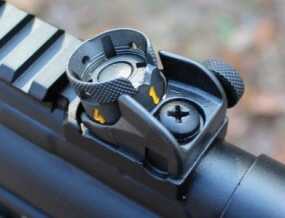
The rear drum sight spins for different range delineation. It is easy to use, and allows for fast adjustment.
The polymer navy-style grip fits my hand well. It is slightly flared and open at the bottom. The grip offers no distinct checkering or texture, though it isn’t slick. The polymer grips were designed for guns destined for salt water environments, as it is one less thing to corrode, and they have caught on well.
Empty, the PTR weighs in at just over 9 pounds. The 16-inch barrel has a 1/10 right-hand twist and is capped with a very functional flash hider. The whole package comes in at 38.75 inches. Like the original H&Ks, the PTR rifles use hooded front sights and rear sight drums that spin for various yardage delineation. The rear sight is adjustable for windage as well as elevation.
The recoil system on the PTR 91 is modeled off of the original roller-delayed blowback made famous by H&K. There is no gas system. Even though the 91 looks like it has a gas tube, there’s no gas running through it. Instead, the blowback drives the bolt to the rear. Rollers on the side of the bolt drive inward against the bolt carrier. It is a mechanically simple and proven system.
One thing to consider when looking at this specific PTR is that there’s very little to modify. The rifle has a welded top rail which offers a lot of room for additions, but there’s no real point in buying a rifle with a matching wooden furniture if you intend to replace the forend or stock. The grip can’t be replaced as easily as that of an AR or AK. The rail eliminates the need for a claw-type optics mounting and makes additions to the rifle much less complicated, but it isn’t going to be removed. Yet this isn’t a base model 91 that you’d be inclined to monkey with. The welded rail and wood furniture are commitments of a kind that will, in part, be why you purchase this exact model, and not one of the other PTRs.
The combination is a handsome rifle that shows some tool marks, which is fine for a working battle rifle. And make no mistake about it; this is a workhorse. The PTR 91 is known for its reliability, accuracy, and ease of use.
SHOOTING
For those who have never shot a PTR 91, or any of the H&K variants, there are a couple of peculiarities. The rifles have left side charging handles.
The lever is way up on the forend, and folds forward, which is exceptionally handy for right-handed shooters. Slide the lever back, and shift it over to lock the bolt. When locked, the charging handle sticks up prominently, and a solid whack from your off hand sends it home. While the gesture isn’t necessary to close the bolt, it is cinematic, and a great follow-up to a pithy line of dialogue right before the shooting starts.
Recoil on the 91 is modest for a .308. The gun kicks, but there’s not as much muzzle rise as you might expect. I find that the gun rises less than an inch, at most, and there’s a subtle right-hand torque, but nothing that would slow down fast repeat shots. The main force from the rifle is the rearward push. I find myself shooting with a wider stance and starting with a forward lean to compensate. Firing fast, my shots tend to walk up the target as I’m pushed more upright.
We sighted the 91 in with 149 grain Federal 7.62 NATO. The iron sights required minimal adjustment. From 100 yards, the PTR ran reliably well.
It is easy enough to connect at 200 yards, standing. While the shorter barrels of the K series rifles lend themselves to close quarters work, the rifle has the potential to be an excellent designated marksman’s gun. Point of aim accuracy out to 100 yards is rock solid.
After 200 rounds of the Federal, we topped the 91 with a Weaver Super Slam and sighted in with Nosler 168 grain. The trigger on our review model prone at 8.2 pounds. I have mixed feelings about the weight of the trigger. For a battle rifle, the trigger is ideal: it is light enough, the break is clean, and there is minimal take up. I’ve heard so much about the accuracy of the PTR 91s. Yet while the rifle is capable of shooting 1 MOA from the bench, I’m not able to reproduce those results standing, or kneeling. Three round groups were consistent, and right at an inch. On several, two of the three rounds would tear through the same hole, but I could never get the third to follow exactly. However, this isn’t a sniper rifle. The 8 pound trigger-pull alone could be the reason I’m missing by half an inch, even with the gun in a vice.
Standing and kneeling, our groups at 100 yards opened up to 2 MOA, or wider. We didn’t have a bipod for the gun, so we didn’t do much prone shooting. After two battle packs of 7.62 Nato, and more than 100 rounds of Nosler trophy and match grade .308, I developed an affinity for the 91. It would make a great battle rifle. Also, the accuracy of the 91 combined with the power of the .308 would make this a good hunting gun (and a great option for hunting hogs).
PTR recommends a break-in period of 300 rounds, with a dedicated cleaning between the early rounds, which can be stepped back as the round count climbs. In the first 20 rounds, we had three hiccups as the spent brass wasn’t ejecting fully. The cases that were caught by the returning bolt were seriously mangled, and with two of those, the PTR locked up good. The next round tried to feed, but couldn’t. This would be less of a problem if the basic design were easier to clear. The position of the charging handle makes it easy to pull back the bolt with the left hand while clearing the jam with your dominant hand (assuming that you are right handed), but it may require a magazine drop, too.
After the first magazine, though, we had no issues. None.
The chronograph results for the rounds were surprising. The 149 grain 7.62 NATO averaged 2,645 FPS. The Nosler Trophy Grade 168 grain .308 clocked in a bit slower: 2,530 FPS. Some of the power loss comes from the shorter barrel, but I’d expected the Nosler to be a bit faster. PTR suggests grain weights between 147 and 152 for maximum accuracy. For what it’s worth, we had better accuracy with the 168 grain Nolser than we did with the 149 grain 7.62 NATO.
PROBLEMS
On our test rifle, the charging handle is a bit stiff. It can take some muscle to get it unfolded. I found that the movement became easier with practice, though I’m still not proficient enough with it to clear any hypothetical jams (or at least not quickly).
My one complaint with the H&K’s design is that it is more cumbersome to press check than most rifles I shoot. The position of the charging handle is fine, but the ejection port is small, and the rounds seat deep inside.
MAGAZINES
The magazines PTR supplies with the rifles are original G3 aluminum magazines. While these magazines aren’t as bomb-proof as AK magazines, they’re inexpensive and plentiful. In addition, the modest availability of the rifle means that the magazines are less likely to vanish during periods of frenetic buying.
We had three magazines we used for the review and never experienced any issues at all. They feel light, but I’m more forgiving of that when I see their price. It isn’t that they’re disposable, exactly, but you wouldn’t ever catch me mourning the loss of one, either. And for those who want a more robust magazine, steel versions are available, too.
CONCLUSIONS
One of the benefits of the H&K G3 is the modularity. PTR makes its own parts and can produce all of the parts needed to build a 91, but the company maintains that modularity, so surplus parts can be incorporated. In situations where 922R compliance is an issue, PTR maintains a minimum of seven U.S. parts. As PTR expands its capabilities, as it is with the current move, the quality of the work is exceeding that of the originals, making surplus parts unnecessary and obsolete. Yet there’s still a touch of homage in the production process. PTR’s steel receivers are made on original H&K machinery imported from Portugal. Barrel production will be done in-house on computer-controlled machines that the original designers of this rifle never dreamed would be possible.
It is that essence of old and new that PTR manages to capture so flawlessly. What’s the cost for this type of accuracy, attention to detail, and reliability? The MSRP for the PTR 91 Classic Wood KR will be $1,225.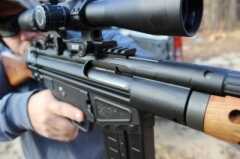
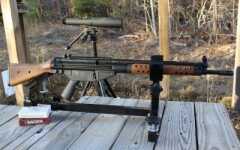


Link List
https://www.nosler.com/ammunitionpage
https://www.ruger.com/products/sr762/models.html
https://www.colt.com/ColtMilitary/Products/ColtModularCarbineCM901.aspx
https://www.federalpremium.com/products/rifle.aspx
/blog/ruger-sr-762-piston-driven-7-62nato-battle-rifle-new-gun-review/


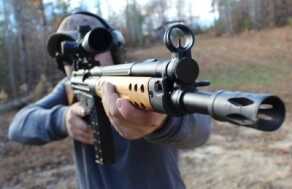

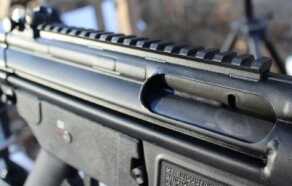


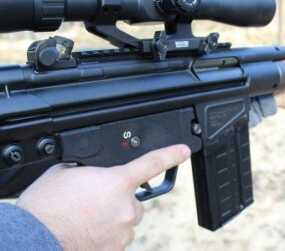
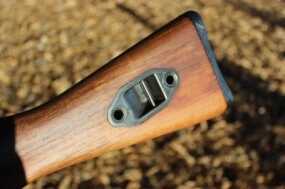
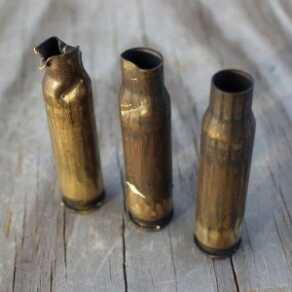


Hey, here it is again.
This was posted about a year ago.
I don’t see my comments.
So here’s a repeat;
I love this nostalgic, ergonomically designed, reliable and battle proven, brass eating tank.
Not to mention a 10+ in the “cool factor” category.
I don’t know why I don’t own one yet, but I will.
I have a ptr 91 and the German army .22 conversion kit….it loves brass
I have a ptr 91 and the German army .22 conversion kit….it loves brass.
Yeah, I do too, but I could never get the conversion kit to work. How did you get it to work? I understand that the conversion hit was actually for the H&K G3.
So, when does the MSG-90 version come out?
I just shot my classic black PTR91. The rifle rocks! I put surplus ammo and Tula through it during the break-in, not one hiccup. It does send the spent casings into outerspace though. The rifle was quite dirty at clean up time. I thought I would never get the barrel clean. I found it to be very accurate, but the sights did need considerable adjustment. My buddy who owns an H&K91 thought it was excellent and had cleaner welds than his H&K91. I am very pleased and have no regrets about buying this rifle.
Hey Randall,
I run dirty Russian surplus in my AK’s all the time.
My tip to you is; Look into, and start using *FrogLube* as your CLP.
Throw out your poisons, breath deep, and simplify your arms cleaning
It’s really a joy to use, and you will not turn back.
http://froglube.com/
Just keep in mind that Froglube – while an amazing product, does not work well in cold weather. The Navy Seals who invented it (it is a Vet owned company so support them) are great guys, and their testing and development occurred 15 minutes from my home. But then the temp gets below 30 F, it gets thick, and the action will get stiff. Since I shoot in warm & cool climates, I also use more traditional, harsh CLPs, in addition to this prodict, but for most applications Froglube is the Bees Knees =)
This is an EXCELLENT article. My arsenal includes a complete HK-91 and a premium upscale PTR (Magpul stock, quadrail etc). First time I shot these guns they massacred spent round and only jammed once. Crappy target ammo was part of the problem and never shoot anybody elses reloads out of these guns. Frequent cleaning and 200 – 300 rounds will produce a reliable weapon that won’t let you down. Very few good guns shoot smoothly out of the box and those that do usually break about the time solid guns like the HK are just getting perfect. So don’t be so tough on breaking in a tough solid gun like the HK 91 and PTR.
Has anybody used Russian .308 tulammo for PTR-91 PDW. Did you have any problems? It coated with some gray stuff and casing gest stock in the chamber in Savage Arms 10 BA .308 after every shoot.
Has anybody used Russian .308 tulammo for PTR-91 PDW. Did you have any problems? It coated with some gray stuff and casing gest stock in the chamber in Savage Arms 10 BA .308 after every shoot.
Has anyone found a good bi pod for the wooden handrail that comes stock from PTR? I am wanting to shoot prone and from a bench.
The real thing is very expensive; http://www.hkparts.net/shop/pc/HK-21-Bipod-NEW-HK-German-p565.htm
MidwayUSA has them at a good price; http://www.midwayusa.com/product/418327/promag-hk-91-93-bipod-16-black
Also.. I have a slight problem with any manufacture recommending 300 rounds break in. Ammo is expensive! So I sit there at night and runing the charging handle /slide/ whatever you are breaking in, a few hundred times. Anyone else have a good break in system that isn’t as expensive as shooting 300 rounds?
I had a PTR91 once. Great rifle, previous owner had taken real good care of it, had a proffesional trigger job done,Williams Triggers I think, amazing, better than my HK91. Neverhad any jams. MUCH better than the Hesse and Century clones I had. The only reason I sold it was to purchase the HK91 NIB. I am considering buying another trigger group and sending it to Williams Triggers for my HK91, so I can have a great trigger without modifying the original trigger.I also put an SG1 stock with a dual buffer, an HK23 sight, and the Hensholdt scope. While I mostly shoot my FN Scar now, I still enjoy putting a few rounds once and awhile through the HK.
I have a PTR91 GI. There are a lot of parts out there. If you decide to get wider handguards or a bipod, that’s an option. You can get get a nice rubber butt pad to soften the recoil (which I recommend). You can also get a folding or telescoping stock, or a stock from magpul with an adjustable comb. Having a welded rail is very nice, but there are also add-on rails available. I had no problems with jams – even with the first 300 rounds. I can recommend any of the PTR 91’s; but you might want to look at models with welded rails and wide handguards.
OBTW – PTR will also be making a version of that rifle in the AK round (7.62×39).
Whenever I get the hankering for one of these CETME pattern rifles I get a look at some ejected brass and change my mind. The roller delayed blowback action destroys brass pretty efficiently. This turns the reloader in me off every time.
I still may get one someday, though, maybe when I ditch my ugly as sin but oh-so-effective 16″ FNAR.
There are a lot of good 308’s out their.
Starting with SCAR 17s, Fn FALS made by Atlanta, AR10s, etc.
I gave up on HK91s because of the fluted chamber. The ripped up brass etc.
The HK was meant to throw the brass so the shooters position wasn’t given to the enemy.
Let’s be realistic, now! An antique design from a time when 7.62X54 rounds were a penny a piece! The simple addition of the factory rubber damper at the ejection portkeeps the brass relatively unscathed and from ejecting into the next county!
The HK91 is one tough rifle. Mine never met a load, including sub-par handloads, it couldn’t feed, fire and eject. Of course the case would be ejected 54 feet away, I measured it. For reloading purposes it was really hard on cases but with extra work the cases could be made reloadable for another go. What I really hated about mine was the 16 lb trigger pull, the heavy weight, poor ergonomics (Germans must have 9″ thumbs to reach the safety).
As mentioned the recoil is not bad but I could definitely feel the differences between loads in a mixed magful. Overall an exceptionally good combat rifle. No way near as versatile/options flexible as a 308 AR. And they do need cleaning, dirtier than a AR in the chamber area.
That stiff charging handle you noted is not a problem, and it’s not because you’re shooting a factory-new gun, and it’s not because you’re not accustomed to the feel of the system. It’s because of the way the roller-lock action works.
The reason the charging handle feels stiff to unfold is because during that part of its motion, you’re working a cam to retract the locking piece to permit retracting the rollers, so the bolt can move out of battery. Once the charging handle is fully unfolded and you’re just sliding it back while sliding the bolt carrier and the whole bolt group through the receiver, you’re only supplying enough force to compress the recoil spring.
Yes, the movement becomes easier with practice, but the handle should never feel “broken in”. If that cam feel is missing or lighter, it means your rollers are worn (after a few hundred thousand rounds) or something else is out of adjustment.
I bought a PTR91 GI during the craze. It wasn’t outrageously priced since it seemed “under the radar”, and since I didn’t have a .308 I figured I would make the jump and I’m glad I did. Like revolver said, it is a tank! Mags are super cheap and eats surplus ammo without a problem. Love this thing enough that I will get another.
I just bought a PTR91 #915150, bull barrel. I haven’t shot it yet but I am selling my DPMS AP4 308 and keeping this. The gun looks good and is built like a tank. Of course, gonna miss the DPMS as it is no slouch. I’m not gonna be shooting many sub moa groups anyway.
PTI , We in South Carolina welcomes you
CETME!!!
I had the same thought. The furniture looks just like the CETME, but as it turns out, that is also what the Germans used when they bought the rights to produce the CETME.
The rear sight is all HK, nothing in common with the paddle-style rear sight on the CETME. And the rail is a welcome transition to the 21st Century. Goodbye claw mounts!
I can see trading in my CETME century clone for one of these.